Government, advocates differ on how to manage population of threatened species

The province says it’s ending Alberta’s 18-year moratorium on grizzly bear hunting, insisting it plans to limit the activity to culling a limited number of problem animals.
But allowing the bruins to be hunted goes against the views of some wildlife biologists, including the government’s own who say research runs counter to it, and has attracted the ire of conservationists who fear the practice could reverse progress made in the grizzly population’s recovery.
“Hunting is not an acceptable management approach for a threatened species,” said Devon Earl, AWA conservation specialist, noting the animals were given that designation in 2010.
“Grizzly bears have a very slow reproductive rate, and trophy hunting could undo all the recovery of the last decade.”
The move under the Wildlife Act was made in a June 17 ministerial order by Forestry and Parks Minister Todd Loewen, which allows him to grant authorization to kill grizzlies if they’re determined by wildlife officers to be habituated or to have killed livestock.
Only bears not with cubs can be hunted and the animals must also be in conflict with humans or in “an area of concern,” states the order.
“Despite its status as a threatened animal, the hunting of Ursus arctos (Grizzly Bear) is permitted under section 53.1 (of the Wildlife Act),” it says.
That review and the new hunt have been driven at least partly by the apparent success of the recovery plan that’s seen the grizzly bear population grow from between 700 and 800 in 2010 to between 900 and 1,150 now, including those in the national parks.
Some government officials and wildlife biologists contend that’s led to an increase in grizzly-human conflict in recent years.
Retired longtime provincial wildlife officer and bear safety expert John Clarke has also said hunting the bears isn’t a solution.
In an email, Loewen’s press secretary said the government is responding to the concerns of farmers and ranchers who’ve lost livestock to grizzlies and fear for their own safety.
Pam Davidson also said that since 2005 there have been eight people killed by grizzly bears and another 62 maulings.
“In addition to grizzly bear-human conflict, there has been 897 livestock loses since 2016 which has impacted greatly impacted Alberta farmers,” she said.
“Through this new network, agricultural producers, rural Albertans and others experiencing negative wildlife interactions are now able to be called upon by wildlife officers (to shoot grizzlies).”
That bear culling done by members of the public will be subject to strict controls and who’ll “be authorized to work with wildlife enforcement officers to respond to wildlife posing a risk to life, livestock, or property.”
Davidson didn’t say how many grizzlies are forecast to be culled if the hunt was recommended by ministry biologists.

‘This seems like a short-sighted decision’
The group Exposed Wildlife Conservancy questioned the involvement of non-professional hunters and expressed concern the move will provide incentives for people to habituate bears so they can trophy-hunt them.
“This seems like a short-sighted decision intended to appease Minister Loewen’s ties to the guide-outfitting and trophy hunting industries and lacks any public integrity,” said the group’s co-founder John Marriott.
“Why wasn’t the public consulted on this? Why weren’t grizzly bear researchers involved in this decision?”
He also said the term “area of concern” in the ministerial order is overly vague and “could apply to anywhere bears and people overlap.”
Not replaced since their retirement two years ago was the province’s only human-wildlife conflict specialist whose work would be preferential to a hunt, said Marriott.
He noted the government’s statistics show the most frequent causes of grizzly mortality caused by people on provincial lands from 2010 to 2019 was illegal hunting, followed by vehicle collisions, then euthanasia.